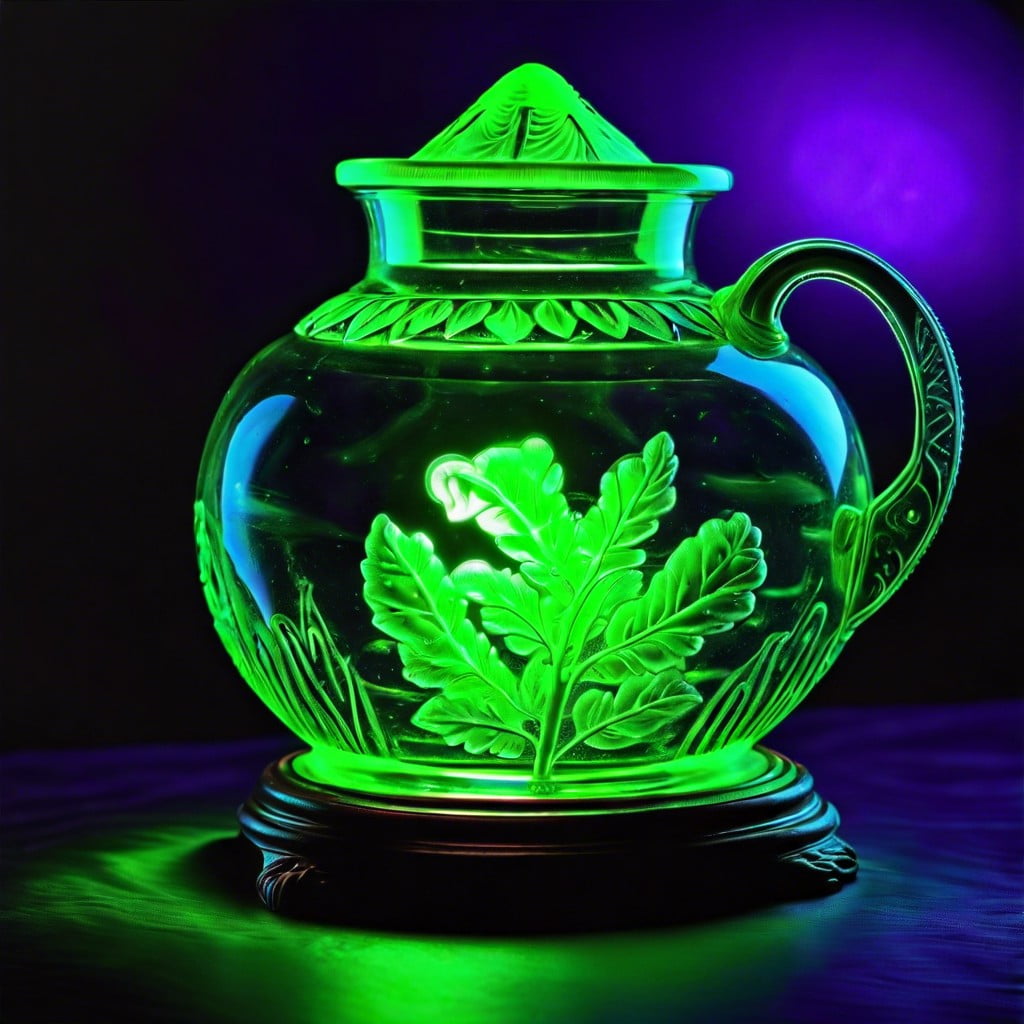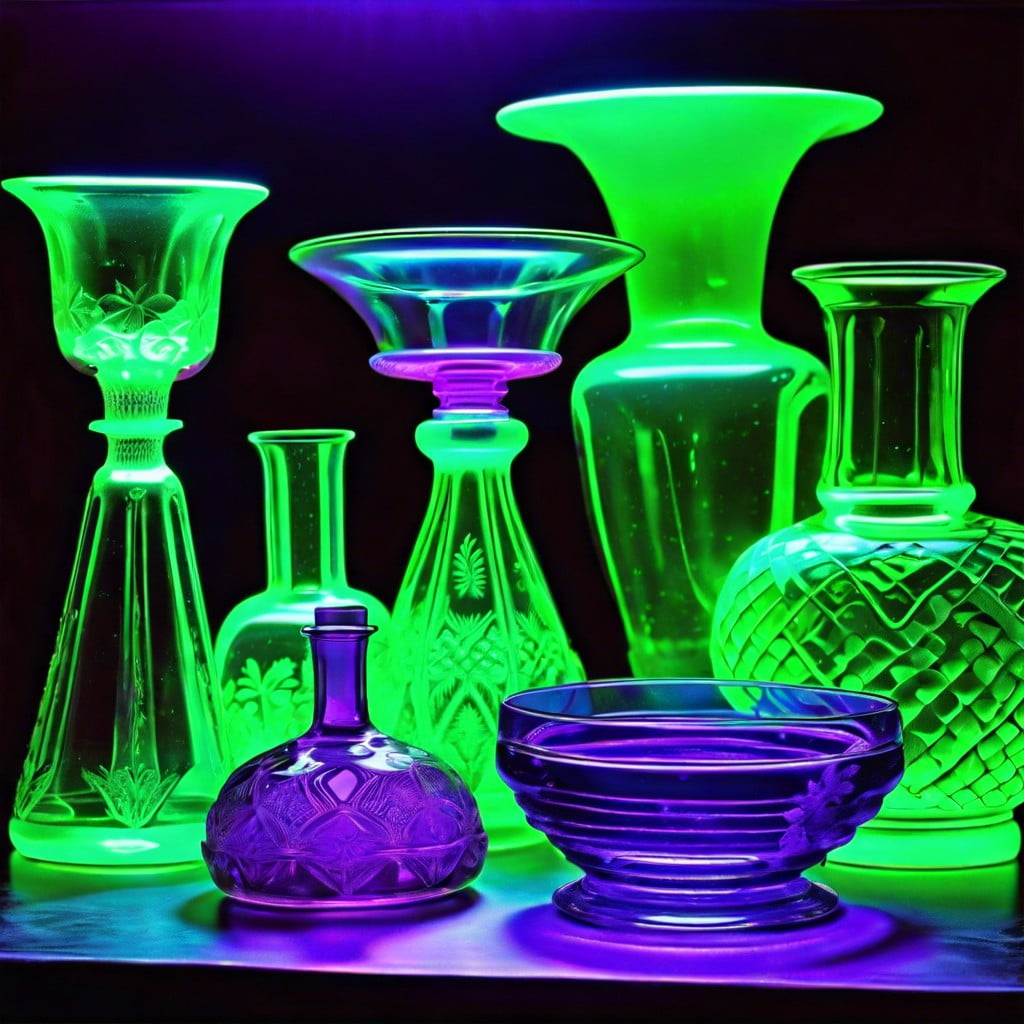Last updated on
Diving deep into an intriguing topic, this article unpacks the safety of uranium glass, because understanding its potential risks is essential for every collector and user.
Key takeaways:
- Uranium glass is generally safe to handle
- Exposure to radioactivity is minimal and depends on factors such as type of radiation, duration of exposure, and radioactive decay rate
- Uranium glass may contain lead, cadmium, and arsenic, which can pose safety concerns
- Uranium glass should not be used in the dishwasher or microwave
- Authenticating uranium glass can be done through visual inspection, UV light fluorescence, and using a Geiger counter.
What Is Uranium Glass?

Uranium glass is a decorative glass variety that derives its characteristic green or yellow hue from small amounts of uranium oxide added to the glass mix before melting. Typically containing anywhere from 0.1% to 2% uranium by weight, its most common form, known as Vaseline glass due to its similar appearance to petroleum jelly, fluoresces under ultraviolet light owing to the uranium content.
First produced in the 1830s and reaching peak popularity in the late 19th and early 20th centuries, it was used primarily for tableware and household items. Although production subsided by the mid-20th century due to concerns about uranium’s use in nuclear weapons, interest in uranium glass has revived among collectors and artisans.
The color intensity of this glass can vary from piece to piece, with the strength of fluorescence providing a remarkable aesthetic under UV light. Despite its uranium content, it is generally considered safe to handle, but it’s essential to understand its radioactive nature and the potential risks associated with prolonged exposure.
Production of Uranium Glass

Uranium glass, distinctive for its green or yellowish-green hue, owes its color to small additions of uranium oxide added to the glass mix during production. Dating back to the 19th century, this process typically involves melting together silica sand, soda, and lime with the uranium compound. The proportion of uranium varies, but it is generally quite low, often less than 1%, and increases the glass’s density, making it heavier than ordinary glass.
Ultraviolet light can stimulate a fluorescent response from uranium glass, often used in verifying its authenticity. Despite these unique attributes, the glassmaking process, in terms of heating and shaping, mirrors that of conventional glasswares. The art of crafting uranium glass peaked in the early 20th century, but some artisans still continue the tradition using stockpiled uranium oxide or substitutes that mimic its glow.
Exposure to Radioactivity From Using Uranium Glass
Uranium glass contains a small amount of uranium to give the glass its characteristic green or yellowish-green color. While uranium is a radioactive element, the levels in this type of glass are generally considered to be quite low. When assessing the safety related to radioactivity, several key points should be taken into account:
1. Type of Radiation: Uranium emits alpha particles, which are not able to penetrate the skin. This means that direct contact with uranium glass doesn’t pose a risk of alpha radiation exposure.
2. Duration of Exposure: The extent of exposure to radioactivity is proportional to the time spent in close proximity to the material. For uranium glass, occasional use, such as display or serving, results in minimal exposure.
3. Radioactive Decay Rate: The specific isotopes of uranium used in the glass determine the rate at which the material is radioactive. Uranium-238, for example, has a half-life of about 4.5 billion years, indicating a very slow decay process and, consequently, low levels of radioactivity.
4. Leaching Potential: If uranium were to leach from the glass into food or beverages, this could increase exposure. Tests have shown that the uranium in the glass does not leach out under normal conditions, thus making the use of the glass for serving food and drinks less concerning from a radiological standpoint.
5. Handling Precautions: It is generally safe to handle uranium glass, but as with any potentially harmful substance, it is wise to wash hands after coming into contact with it, especially before eating or touching the face.
These points suggest that while uranium glass contains radioactive material, the health risks from handling and using it under normal conditions are negligible. However, if there are any concerns about radiation levels, a Geiger counter can be used to measure the specific activity of a piece of uranium glass.
Lead, Cadmium & Arsenic in Uranium Glass
In addition to the small amounts of uranium used to give uranium glass its characteristic color, historical production methods sometimes incorporated other elements, such as lead, cadmium, and arsenic, to enhance durability and optical properties. However, these elements raise safety concerns when present:
1. Lead: Renowned for improving the sparkle and weight of glassware, lead can pose a health risk if it leaches into food or drink. Modern safety standards typically restrict its use in items intended for food or beverage consumption.
2. Cadmium: Cadmium might have been used to create red, orange, or yellow colors in glass. Though it helps achieve vibrant hues, cadmium is toxic, and exposure can occur through direct contact.
3. Arsenic: Historically used in glass manufacturing to remove discoloration, arsenic, like lead, could be part of the makeup of some old uranium glass pieces. Direct ingestion or long-term exposure to arsenic is hazardous.
Collectors of vintage glassware should be aware that not all uranium glass contains these elements, and the risk of exposure can vary widely. Practical measures, such as using uranium glass for display purposes rather than for serving food or drink, can greatly reduce any potential risks associated with these substances. Additionally, with advancements in glass production, contemporary uranium glass typically conforms to modern safety regulations, minimizing or eliminating the use of hazardous materials.
Is Uranium Glass Dishwasher and Microwave Safe?
Uranium glass, while a fascinating collector’s item, warrants careful handling. Regarding dishwashing, it’s recommended to steer clear of high temperatures and harsh detergents that could potentially damage the glass surface or cause fading over time. Manually washing with a gentle cleaner maintains the integrity and luminance of the glass.
When it comes to microwaves, it’s best to avoid the temptation entirely. The metal oxide in the glass, which gives it a glow under UV light, is not microwave safe. Microwaving uranium glass could result in damage to both the microwave and the glassware. It’s essential to note that while uranium glass can be functional, its primary value lies in its uniqueness and aesthetic appeal, not in its utility for modern kitchen appliances. For these reasons, traditional use without involving extreme heat or radiation is the way to preserve this distinctive glassware.
Identifying a Real Uranium Glass
Differentiating authentic uranium glass from imitations initially relies on its distinct green or yellow coloration. When exposed to ultraviolet light, genuine uranium glassware reveals a characteristic fluorescence, radiating a neon green hue, a property absent in non-uranium-based glass. This luminescence test, performed with a black light, is a quick and reliable method to verify the presence of uranium.
Another method is examining the weight and clarity of the piece. Due to the density of uranium, these glass items tend to be heavier than typical glassware and often possess a glossy finish with a slight tint, ranging from yellow to green depending on the concentration of uranium.
For collectors and enthusiasts interested in a more scientific approach, a Geiger counter can measure the radioactivity levels, confirming uranium content, albeit at levels typically deemed safe for handling and display. In absence of these tools, seeking expert appraisal or utilizing a professional identification service can provide authentication certainty for collectors and buyers.
Is Uranium Glass Dangerous?
Uranium glass emits low levels of radiation, but the amount is typically well below the regulatory thresholds deemed hazardous. It is primarily alpha radiation, which has minimal penetrating power and can be stopped by a sheet of paper or the outer layer of human skin.
The health risks from handling or using uranium glass, such as drinking from a uranium glass goblet or using a plate, are considered negligible.
However, it’s prudent to exercise caution in specific scenarios. For instance, if the glass were to shatter, the small shards could pose more of a risk as the material could conceivably be ingested or inhaled, which means the radioactive particles could enter the body.
In addition, while everyday use is considered safe, using uranium glass for food storage or as containers for acidic substances might warrant reassessment, as increased contact with consumables poses a greater potential for exposure to the uranium.
To mitigate any potential risk, it’s recommended to use uranium glass primarily for decorative purposes. For those concerned about exposure, it is also advisable to limit the frequency of use and to avoid using it with food or drink altogether.
In any case, the rarity and uniqueness of uranium glass often make it a collector’s item, appreciated more for its aesthetic qualities rather than its functionality in the modern home.
Geiger Counter Test for Uranium Glass
A Geiger counter serves as a tangible tool for detecting and quantifying radiation emissions, including from items such as uranium glass. When testing uranium glass, the following points can facilitate understanding and ensure accurate readings:
- Geiger Counter Basics: This device detects and measures ionizing radiation. It does so by indicating the presence of particles emitted by radioactive materials through audible clicks or digital readouts.
Testing Procedure: When using a Geiger counter, place the sensor close to the glassware. A higher-than-background reading signifies the presence of uranium, confirming the item’s authenticity.
Interpreting Results: Not all Geiger counters measure alpha, beta, and gamma radiation. Ensure the selected Geiger counter is sensitive to the type of radiation expected from uranium glass.
Safety During Testing: Although the radiation levels from uranium glass are generally considered low and well below the threshold for health risks, it’s essential to minimize direct contact during testing and to handle both the Geiger counter and glassware carefully.
Consistent Baseline: Before testing your glass, establish a consistent radiation baseline measurement by taking readings in the environment away from the glass to compare against the readings when testing the item.
This Geiger counter test can differentiate authentic uranium glass from replicas lacking radioactive elements and provide some assurance regarding the safety and handling of these collectible items.
Is Uranium Glass Valuable?
The value of uranium glass can be influenced by various factors. Rarity plays a significant role; pieces produced in limited quantities or specific historical periods are typically more sought-after by collectors. The condition of the glass is also critical, with items free of cracks, chips, or repairs commanding higher prices. Additionally, the design and craftsmanship contribute to the value, with intricate patterns and well-known manufacturers like Fenton or Vaseline Glass being more desirable. The fluorescence of the glass under UV light, which is a hallmark of authentic uranium glass, can also affect its worth. Color is another factor, as certain hues are more rare and popular with collectors. It’s essential for enthusiasts to research individual pieces, as the market for collectibles can fluctuate.
Factors Influencing the Value of Uranium Glass
Several factors bear significant influence on the valuation of uranium glass pieces. Age stands as a primary determinant; older pieces often command higher prices, particularly those from the late 19th to early 20th century. Rarity also adds to an item’s worth – unique shapes, patterns, and colors may pique the interest of collectors, driving up demand and value.
The condition is paramount; any chips, cracks, or scratches can drastically decrease a piece’s market appeal. Provenance can augment value, as items with a verifiable history or connection to significant events or personalities are usually more coveted.
Craftsmanship and maker marks contribute to a piece’s collectability and monetary value. Well-known manufacturers or artisans who are recognized for their high-quality work often produce items that are sought after by enthusiasts.
Finally, the glow—a distinctive property of uranium glass under UV light—is a visual allure that can influence desirability. A strong, bright fluorescence can make for a more impressive display and can be especially appealing to collectors, thus potentially increasing value.




